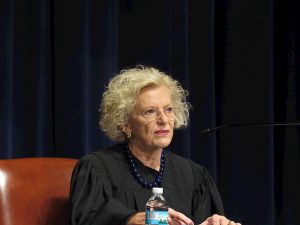State Supreme Court declines to rule on FOID Act for second time
By Jerry Nowicki Capitol News Illinois — June 17, 2022
Chief Justice Anne M. Burke, pictured in a file photo, wrote a majority opinion that was released this week in which the Supreme Court declined to rule on the constitutionality of the state’s Firearm Owners Identification Act. (Blueroomstream.com)
SPRINGFIELD – In a 4-3 decision with a blistering dissent from the Republican minority, the Illinois Supreme Court declined to rule on a question of whether Illinois Firearm Owners Identification Act is unconstitutional.
It was the second time the case of the People v. Vivian Brown came before the court and the second time the court declined to rule on the constitutionality of the state statute requiring Illinoisans to receive a permit to legally own a gun.
The majority opinion released Thursday was written by Chief Justice Anne M. Burke and was procedural in nature. It contended that the White County Circuit Court failed to adhere to the Supreme Court’s previous 2020 ruling in the case, so it once again vacated the lower court’s ruling that the FOID Act was unconstitutional.
Burke was joined in the majority by Democrats Mary Jane Theis, P. Scott Neville Jr. and Robert Carter.
Justice Michael Burke – who is not related to the chief justice – wrote the dissent, making up 11 of the 21 pages in the Thursday order.
He argued the majority decision was “based on a misunderstanding of the record and a misreading of this court’s precedents,” and that it could keep the defendant in “legal limbo” for an untold period of years.
The case involves a White County resident, Vivian Claudine Brown, who was charged in March 2017 with possession of a firearm without a FOID card after police responded to her estranged husband’s call that she had fired a gun in her home.
Police found the rifle but no evidence that she fired it. Nonetheless, she was charged with the crime.
But a circuit judge in White County threw out the charge, ruling that the fees and forms required to receive a FOID imposed an unconstitutional burden on Brown’s Second Amendment right to keep a firearm in her own home.
But it was an alternative ruling made by the same court without prompting from Brown’s legal team that allowed the state’s high court to decline to rule on the constitutional grounds.
That alternative ruling contended that the Illinois General Assembly, when it passed the FOID Act, never meant for it to apply in the home, because if it did, it would mean anybody with knowledge of a firearm and exclusive control over the area where it was kept could be construed as possessing the gun.
As a general rule, courts decline to rule on constitutional matters when a case can be decided on other grounds.
Because the circuit court ruled on an aspect of the FOID Act pertaining to state law, the Supreme Court’s 2020 decision vacated the order pertaining to constitutionality and sent the matter back to White County to “permit the normal appellate process to run its course.”
The ruling was essentially a win for Brown, but her legal team contended it wouldn’t stand up to an appeal. Thus, Brown’s attorneys filed a motion to reconsider, arguing that the inevitable loss on appeal would delay clarity in the case.
The circuit court agreed and reinstated the charges. Brown’s attorneys then filed a new motion to dismiss on constitutional grounds, which the judge upheld, finding that “any fee associated with exercising the core fundamental Constitutional right of armed self-defense within the
confines of one’s home violates the Second Amendment.”
Thus, the state appealed the ruling back to the Supreme Court, leading to the Thursday ruling in which the majority decided the lower court had no authority to reconsider the case after the Supreme Court’s 2020 ruling.
“When a cause is ‘remanded by the reviewing court with instructions to the circuit court to enter a specific order, the reviewing court’s judgment is, with respect to the merits, ‘the end of the case,’ and there is ‘nothing which the circuit court [is] authorized to do but enter the decree,’’” the court wrote, quoting other case law.
If the lower court were allowed to make changes to the Supreme Court’s ruling, the majority wrote, it would set a precedent “upending our hierarchical judicial system.”
The dissent from Michael Burke, however, argued that the majority asserted finality of its ruling while also suggesting that the proper place for review is now an appellate court, which is itself a lower court.
“In reality, the judgment of the circuit court was not a judgment of this court that was final and conclusive on all the parties because this court declined to reach the merits of the statutory analysis and only vacated the circuit court’s judgment on procedural grounds,” Michael Burke wrote in the dissent. “Accordingly, the trial court was free to reconsider the merits of that ruling, and nothing about it doing so upends our hierarchical judicial system.”
Michael Burke argued that the majority’s supposition that Brown received “complete relief” when the circuit court vacated her charges was faulty, because the legal reasoning backing that decision is unlikely to hold up upon appeal.
Thus, he predicted, the case will ultimately end up back at the Supreme Court on the constitutional basis, only after a significant delay to Brown’s detriment as the case moves through the appellate court.
jnowicki@capitolnewsillinois.com







